23 August, 2000
I had a restless sleep with the nightly activity of an old folk's home. I
got myself out of bed at 8am to eat some delicious oatmeal and then went
back to my room and slept until 11am. I could hear Josh and Dr. Radtke in
the other room and so dressed and went to find out the plan for the day.
Again the word from the helicopters was that they were grounded due to the
fog. They were hoping to make one flight later that day. There were people
stranded at Thule Air Base and they would be the top priority when the
flights resumed.
Outside there is a slight drizzle; Josh and I went to the grocery store to
get some plastic bags for the trip and then checked out the route to the
craft store named Ultima Thule. Ultima means farthest north. Pytheas of
Massalia around 325 BC used the name Thule to name an island he discovered
it six sailing days north of England. It is generally believed that that
island was present day Iceland. After reconnoitering, we decided we could
pull/push Dr. Radtke's modified chair to the store, but getting in the
building may be a problem.
We returned to lunch which was ox tails, vegetable soup, and custard. I
hadn't seen any lettuce since being on the air base. It is not part of the
local cuisine, in fact I had not seen people eating any fresh vegetables
here.
We then progressed to Ulitma Thule, whose hours are from 1-2pm on
Wednesdays, not quite the same store hours as a 7-11. This was my first
time helping to get Dr. Radtke into the chair and helping to pull/push. We
finally worked out the idiosyncrasies of the new crew and I ended up pulling
and steering as Josh became the keel, giving support directly by the chair.
(See pic of chair.)
Arriving at the Ultima Thule we were helped by two men, who were trading
inside, to move the chair with Dr. Radtke into the first floor of the
building. The inside was painted a burnt red purple with many interesting
things displayed where ever we looked. Most were crafts made from the
inedible parts of the animals that are the major food items in
Qaanaaq--walrus, seal, polar bear, and narwhal. There were also arctic fox
pelts. Things were not cheap ranging from $8 for a bear claw to necklaces
up to $100 and a polar bear skin over a $1000. Of course for us, it is
illegal to bring into the states items made from marine mammals. This hurts
the Inuit trade in these crafts with US tourists; since these people
survive on the hunting of these animals for a food source, they think it an
unfair practice. There were some things made out of reindeer that we could
purchase.
Some of the common carvings were creatures representing a tupilak. The
tupilak is a man made creature whose mission is to find and kill a specific
personal enemy. The maker of the tupilak used parts of various
animals--bones, teeth, skin, beaks, claws, skulls, but most important was
some bit from the intended victim. Hairs or shavings from nails were the
easiest items to obtain. These bits of personal tissue made it easier for
the tupilak to track down the victim. When the tupilak was physically
finished it was given life by rubbing the tupilak against one's genitals and
then to place it into a river or the sea to track down and kill the victim.
The tupilak was a sure killer, but the maker ran one risk. If the victim
was stronger in magical power than the maker he could reverse the tupilak,
which would then inevitably return to kill its maker.

Josh checking out the terrain over which we have to pull the chair.
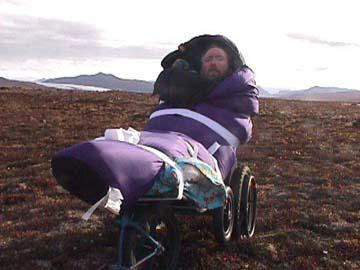
A shot of Dr. Radtke bundled into the chair on the tundra. One person walks behind Dr. Radtke and pushes. Out of view is the square metal frame inside which the second person will walk and pull.

Arctic fox skins. These were the reason that Knud Rasmussen set up the first trading station at Thule. Although Rasmussen is a national hero, he is controversial in some circles for establishing a trade based on the hunting of animals not used as food, which took time away from securing food and eventually the independent lifestyle of the Inuit.
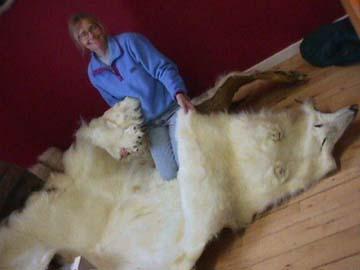
Closest I got to a polar bear.
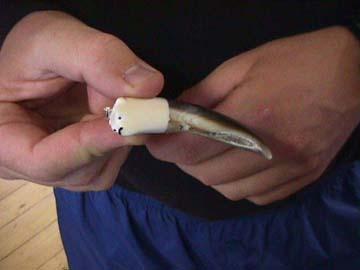
Josh holding a polar bear claw attached to an ivory carving.
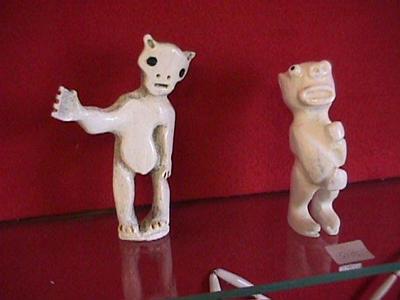
Tupilak
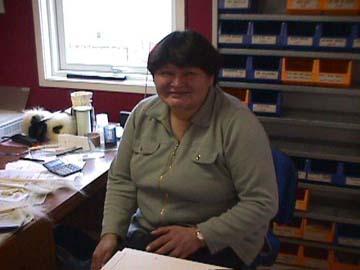
Marie-Stine Hansen, one of the proprietors of Ultima Thule.

Contact the TEA in the field at
.
If you cannot connect through your browser, copy the
TEA's e-mail address in the "To:" line of
your favorite e-mail package.
|
